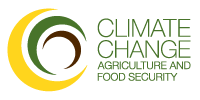The CCAFS study on "Climate Change in CCAFS Regions: Recent Trends Current Projections, Crop Climate Suitability, and Prospects for Improved Climate Model Information" features four parts on: West Africa; East Africa; the Indo-Gangetic Plains; and Progress in Climate Science Modelling.
 21 September 2011: The Climate Change, Agriculture and Food Security (CCAFS) Program of the Consultative Group on International Agricultural Research (CGIAR) hosted a science video seminar to accompany the launch of a study on “Climate Change in CCAFS Regions: Recent Trends Current Projections, Crop Climate Suitability, and Prospects for Improved Climate Model Information.”
21 September 2011: The Climate Change, Agriculture and Food Security (CCAFS) Program of the Consultative Group on International Agricultural Research (CGIAR) hosted a science video seminar to accompany the launch of a study on “Climate Change in CCAFS Regions: Recent Trends Current Projections, Crop Climate Suitability, and Prospects for Improved Climate Model Information.”
The study features four parts on: West Africa; East Africa; the Indo-Gangetic Plains; and Progress in Climate Science Modelling. During the video seminar, two of the authors, Mark New and Richard Washington, presented the study, which assesses the implications of climate change for agriculture, with a particular focus on those aspects of climate change that will have greatest impact on the crops currently grown in each region.
The part on West Africa underlines that the influences and interactions that control the climate of the region are complex and models have difficulty in simulating the observed climate. It also highlights mixed results of models on whether the Sahel will experience drier or wetter conditions over the 21st century.
In East Africa, the study focuses on maize, cassava and banana. On bananas, the models note that the absolute extent of crop growth is not likely to change over the 21st century in East Africa and that new opportunities may emerge for growing bananas in some country. The models predict that maize will will not be impacted significantly over the coming century, and that climate will introduce few adverse impacts on the suitability of cassava.
In the part on Indo-Gangetic Plains, the authors stressed the driving role of the monsoons and the factors that predict monsoon behavior. They note large differences in suitability for growth depending on irrigated or rain-fed situations. The authors underscore that careful evaluation of results are required to identify global and regional models that satisfy basic performance characteristics across regions of interest.
The part on prospects for climate modelling shows that there are considerable uncertainties in climate projections in all three regions from global models. It underscores that the performance of global models at regional scales has not improved drastically over the last ten years, and recommends the carrying out of careful evaluation of results to identify both global and regional models that satisfy basic performance characteristics over the CCAFS regions. [CCAFS Video Seminar: How Good are Current Climate Models for Predicting Agricultural Impacts in Africa and South Asia] [Publication: Recent Trends, Current Projections, Crop-Climate Suitability, and Prospects for Improved Climate Model Information]